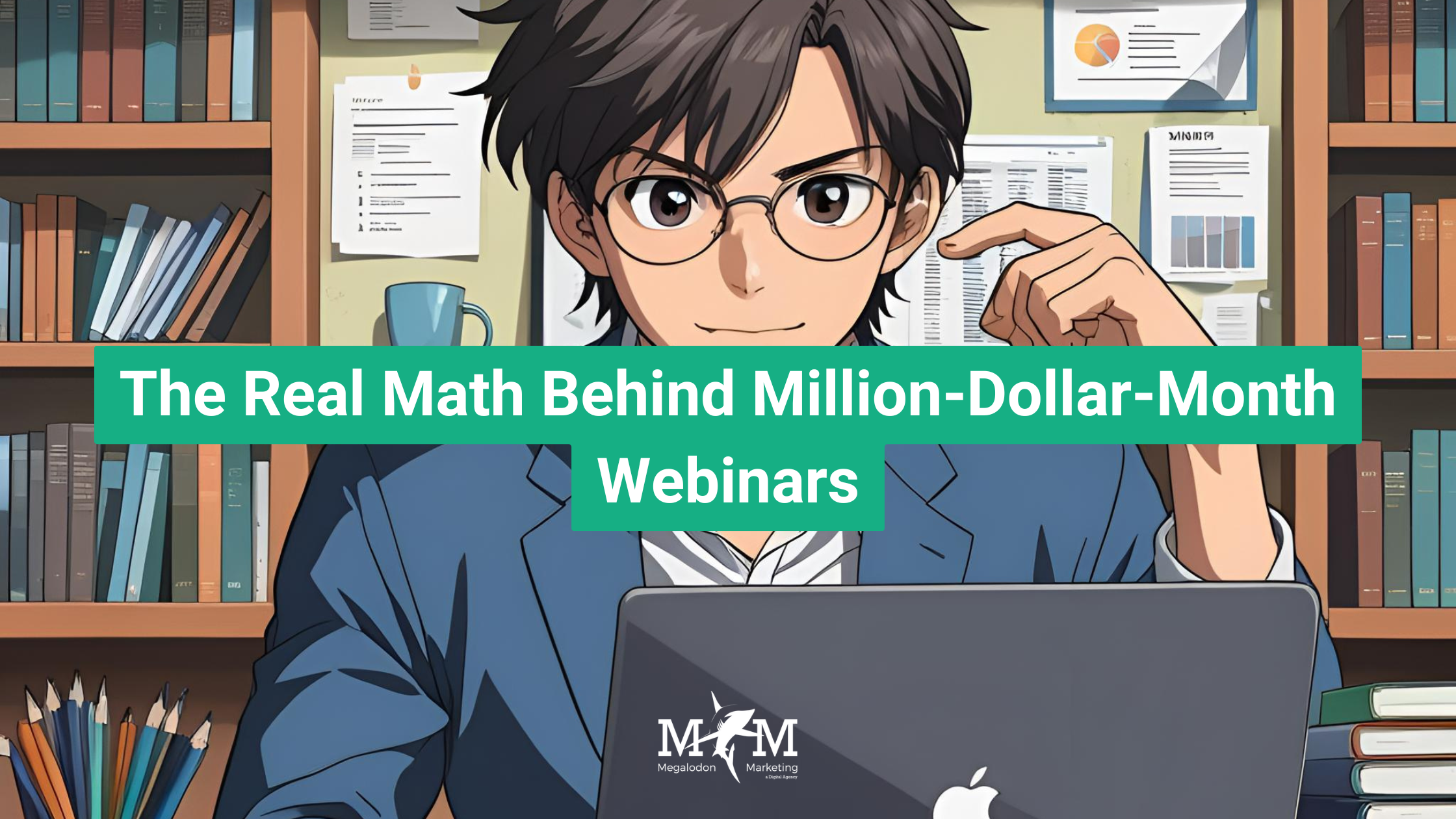I hope you enjoy reading this blog post. If you want my team to just do your marketing for you, click here.

I hope you enjoy reading this blog post. If you want my team to just do your marketing for you, click here.
Author: Jeremy Haynes | founder of Megalodon Marketing.

Earnings Disclaimer: You have a .1% probability of hitting million dollar months according to the US Bureau of Labor Statistics. As stated by law, we can not and do not make any guarantees about your own ability to get results or earn any money with our ideas, information, programs or strategies. We don’t know you and, besides, your results in life are up to you. We’re here to help by giving you our greatest strategies to move you forward, faster. However, nothing on this page or any of our websites or emails is a promise or guarantee of future earnings. Any financial numbers referenced here, or on any of our sites or emails, are simply estimates or projections or past results, and should not be considered exact, actual or as a promise of potential earnings – all numbers are illustrative only.
Watch the full video breakdown on this topic here.
1. Webinars are a lumpsum gamble, not a daily lead drip.
Unlike call funnels or DM strategies that trickle cash, a webinar deposits (or withdraws) a heavy chunk of revenue inside a 72-hour window. Treat it like a casino table: you front chips, spin once, and calculate whether you bought yourself more playtime or walked away lighter.
2. Your first objective is house money.
Before blitzing cold traffic, squeeze your organic and warm audiences until the funnel pays for itself. The cushion you create funds the iterations and ad spend required to make strangers convert at scale.
3. Audience temperature dictates the playbook.
Organic followers forgive stumbles and stick around for 120-minute marathons. Cold prospects are razor-judgmental; if value density dips, they vanish. Your deck length, proof, and even cost-per-lead projections shift with the thermostat of the room.
4. Research trumps reinvention.
Tom Cruz has hosted a Wednesday webinar for four straight years and hates sales reps—yet clears enviable numbers because his skill matches his medium. Russell Brunson opens the pitch by asking permission to sell and watches conversion rates spike. Steal before you invent; it shortens the distance to profitability.
5. Financial modeling is non-negotiable.
“Feeling” good about a $20 K test budget is fantasy. Run it through a real model—lead cost, show rate, retention at the pitch, call-booking percentage, and close rate—before you wire a cent to Meta or Google. The spreadsheet will reveal whether the risk is worth taking or whether another funnel deserves the cash.
Across forty-one businesses we’ve driven past the seven-figure monthly mark, two groupings emerge:
Either way, webinars are fundamental once your ticket price pushes north of $5 K. They compress education, authority, social proof, and order-taking into one ninety-minute cinematic heist. But only if you build—and bet—correctly.
I make zero income claims here. Nothing in this article guarantees you a dime. What follows are patterns that surfaced by watching what works—and, more instructive, what detonates budgets—in the real world.
Shockingly, most founders hell-bent on “doing a webinar” have never sat through a high-performer’s session start to finish. That’s like storming a high-stakes baccarat table without ever seeing a hand dealt.
Tom Cruz, the Section 8 real-estate legend, despises having closers on payroll. Nearly all revenue pours in through his weekly Wednesday webinar and follow-up DMs. He has repeated that cadence for years. Imagine the micro-optimizations he’s baked in: opening hooks that slice drop-off, slide pacing that keeps sophisticated landlords engaged, and Q&A frameworks that surface hidden objections before the pitch. Attend once and you’ll harvest a notebook of tweaks—no direct competition required.
Brunson’s now-canonical move is elegant. After sixty minutes of wall-to-wall value, he pauses:
“I have a deeper, paid way to help you.
If it’s okay for me to walk you through it, could you drop a quick ‘yes’ in the chat?”
Hundreds type yes. The crowd asks to be sold, compliance spikes, and the pitch lands on fertile ground. One sentence, yet many presenters skip it and wonder why buy-rate lags.
Block two afternoons this week to attend live webinars in and outside your niche. Show up with a detective’s pad. Catalog every transition, every social-proof insert, every chat prompt. You will shave months off your trial-and-error curve.
Webinars are group selling. Some founders roar on stage; others freeze. Either way, mastery boils down to three phases:
Group selling is a skill you drill. The first run may feel clunky. That’s normal—and why starting with sympathetic audiences matters.
| Audience | Show Rate | Tolerance for Imperfection | Ad Spend Risk |
|---|---|---|---|
| Organic followers | 30–40 % | High—they already binge your posts | $0 (sweat equity only) |
| Warm retargeting | 20–25 % | Moderate—they’ve clicked before | Low-moderate |
| Cold paid traffic | 10–15 % | Near-zero—they judge every slide | Highest |
Why sequence matters
Launching to organic first scores house money—profit you didn’t have to buy. That bankroll cushions the burn while you hammer cold traffic into submission.
Webinars are high-variance plays. All your ad dollars concentrate into a single date; if you whiff, there’s no daily lead flow to soften the blow. The solution is to stockpile house money early:
House money covers the iterations you’re guaranteed to make: rewriting decks, tightening follow-up sequences, retraining the sales team, and upping ad budgets once metrics flash green.
Assume you’re eyeing a cold-traffic launch and feel “comfortable” spending $20 K. Before you do, interrogate the numbers.
| Variable | Assumption | Result |
|---|---|---|
| Cost per registrant | $20 | 1 000 regs |
| Show rate | 10 % | 100 attendees |
| Retention to pitch (minute 60) | 70 % | 70 still watching |
| Call-booking rate | 20 % | 14 calls set |
| Call show-rate | 50 % | 7 calls held |
| Sales close rate | 30 % | 2 sales |
If your product sells for $5 K, you gross $10 K—half your ad spend. Even a $10 K product only nets break-even. Options:
Run that model pre-launch. Numbers don’t lie; feelings do.
A real-estate educator selling a $70 K mentorship dove straight into cold ads:
Only shove chips in when all of these are true:
Then—and only then—do you graduate from $20 K pokes to $80 K punches.
Webinars reward ruthless honesty about your strengths.
Remember the $20 K-per-webinar real-estate pro? Burning a batch of cash hurt—but the lesson never repeated. That’s professional tuition, not waste.
Webinars are the high-stakes table of digital marketing. Step up with a plan, bankroll your learning curve with house money, and respect the numbers more than your ego. Do that and the same ninety-minute presentation can bankroll million-dollar months, week after week, while less disciplined players wonder why their chips disappear before the first shuffle is done.
Need deeper help? My private Inner Circle and Master Internet Marketing cohorts exist for founders already north of six figures who refuse to plateau. If that’s you, reach out. Otherwise, take this blueprint, hit the trenches, and start printing your own house money. Stay sharp—and I’ll see you at the million-dollar table.

Jeremy Haynes is the founder of Megalodon Marketing. He is considered one of the top digital marketers and has the results to back it up. Jeremy has consistently demonstrated his expertise whether it be through his content advertising “propaganda” strategies that are originated by him, as well as his funnel and direct response marketing strategies. He’s trusted by the biggest names in the industries his agency works in and by over 4,000+ paid students that learn how to become better digital marketers and agency owners through his education products.

Jeremy Haynes is the founder of Megalodon Marketing. He is considered one of the top digital marketers and has the results to back it up. Jeremy has consistently demonstrated his expertise whether it be through his content advertising “propaganda” strategies that are originated by him, as well as his funnel and direct response marketing strategies. He’s trusted by the biggest names in the industries his agency works in and by over 4,000+ paid students that learn how to become better digital marketers and agency owners through his education products.
This site is not a part of the Facebook website or Facebook Inc.
This site is NOT /endorsed by Facebook in any way. FACEBOOK is a trademark of FACEBOOK, Inc.
We don’t believe in get-rich-quick programs or short cuts. We believe in hard work, adding value and serving others. And that’s what our programs and information we share are designed to help you do. As stated by law, we can not and do not make any guarantees about your own ability to get results or earn any money with our ideas, information, programs or strategies. We don’t know you and, besides, your results in life are up to you. Agreed? We’re here to help by giving you our greatest strategies to move you forward, faster. However, nothing on this page or any of our websites or emails is a promise or guarantee of future earnings. Any financial numbers referenced here, or on any of our sites or emails, are simply estimates or projections or past results, and should not be considered exact, actual or as a promise of potential earnings – all numbers are illustrative only.
Results may vary and testimonials are not claimed to represent typical results. All testimonials are real. These results are meant as a showcase of what the best, most motivated and driven clients have done and should not be taken as average or typical results.
You should perform your own due diligence and use your own best judgment prior to making any investment decision pertaining to your business. By virtue of visiting this site or interacting with any portion of this site, you agree that you’re fully responsible for the investments you make and any outcomes that may result.
Do you have questions? Please email [email protected]
Call or Text (305) 704-0094